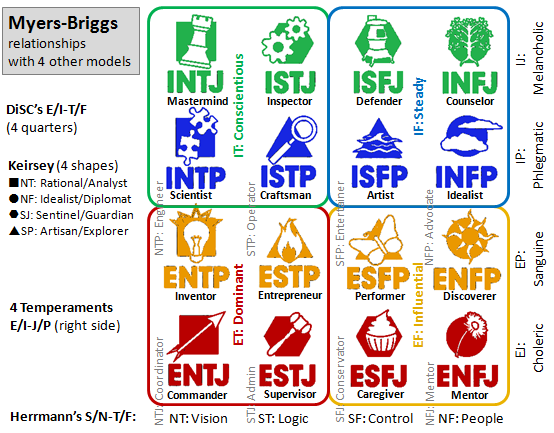Personality Models: Myers-Briggs and others
By Matthieu on Monday, May 22 2017, 12:45 - Permalink
Know Thyself!
Direct experience of one's feeling and behavior is best, but some nerdy scientific or pseudo-scientific models of psychology can help putting words on it.
Personality models can be split into 2 categories: those with odd and even numbers of types.
The models with odd numbers (Enneagram, Chinese 5 Agents 五行, 9 Belbin Team Roles, etc.) define the personalities without analyzing them as mere combinations of aspects. They describe each of them as a whole that is more than just a sum of components: these are holistic approaches.
The models in even numbers by contrast are taking analytic approaches: they analyze the personalities as combinations of aspects, based on binary oppositions: Introvert/Extrovert, Active/Passive, Rational/Intuitive, Conservative/Progressive, Indirect/Direct, etc.
Following the tradition of Carl Jung in analytic psychology, the Myers-Briggs Type Indicator (MBTI), takes this analytic approach to a high degree, by defining 4 aspects:
- Extrovert/Introvert: being with others stimulates us, or makes us uncomfortable and exhausted?
- Mode of perception: Sensing/iNtuiting: do we sense the practical facts and objective reality, or do we intuitively get the big picture, and the underlying principles?
- Mode of judgment: Thinking/Feeling: do we decide objectively based on logic and justice, or subjectively with empathy, forgiveness, and aiming at harmony?
- Dominance between the 2 modes: Judging/Perceiving: need for plan and achievement within clear framework and deadlines, or comfortable with improvising in flexible environment?
The combinations of the 4 pairs of letters (E/I, S/N, T/F, J/P) gives the 16 types. Selecting only 3 letters will define a pair of types, and 2 letters defines a group of 4 types (see comments below the diagram)
I have tried to integrate into the above MBTI chart 4 other models:
- Herrmann Whole Brain Thinking, which seems to focus on the aspects Thinking/Feeling and Sensing/iNtuiting. Captions at the bottom of diagram, splitting into 4 columns.
- The Greek Four Temperaments, related to my proposal of cardinal cycle, which opposes Introvert/Extrovert, and Stable/Unstable. Captions on the right side of the diagram, splitting into 4 lines.
- DiSC Assessment, which opposes Active/Passive and People/Task. Splitting the above diagram into 4 quarters.
- Keirsey Temperament Sorter, which is often presented in connection with the MBTI. It is represented by 4 shapes, with captions on the left side.
There have been quite many 4-types personality models across history, but matching the types one by one is often too direct. The above diagram uses the wider playground of the MBTI to compare the models more subtly.
So.. what about myself? You can try to classify me as INTP, but also ENTP when in contact with peoples, INFP and INFP when I listen more to my heart (these 4 types form a NP group), and also ISTP and ISFP at time when i get more pragmatic.

Comments
I seems that what we think we should do also influences the result. For example, i think that i should plan more, and i feel good when i do